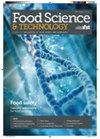Nutrients and bioactive compounds in wild fruits from the Brazilian Amazon rainforest
Q2 Agricultural and Biological Sciences
引用次数: 0
Abstract
The Amazon Rainforest presents a great diversity of wild fruits that constitute an important part of the diet of many families. The present study investigated the nutritional composition of pequiá (Caryocar villosum (Aubl.)), camapu (Physalis angulata L.), tucumã (Astrocaryum vulgare Mart.), uxi (Endopleura uchi (Huber.)), and bacaba (Oenocarpus bacaba Mart.). Gravimetric methods were used to determine moisture and ash after drying in an oven and a muffle furnace, respectively. Total phenolics by Folin-Ciocalteu method, carotenoids by HPLC-DAD, and minerals by atomic absorption spectrophotometry were used. C. villosum obtained the highest concentration of carbohydrates and K; P. angulata showed the highest concentration of Mg; A. vulgare obtained the highest concentration of dietary fiber and carotenoids; E. uchi had the highest concentration of Ca and the highest total energy value; and O. bacaba showed the highest concentration of proteins, P, and total phenolics. It was observed that the species A. vulgare presented the highest concentrations of the main nutrients analyzed; carbohydrates manifested in greater quantity in the species C. villosum, while phenolics were in the species A. vulgare and O. bacaba. The nutritional values found in these fruits are superior to those of other species consumed in Brazil, especially those arising from genetically improved crops.巴西亚马逊雨林野生水果中的营养成分和生物活性化合物
亚马逊雨林中的野果种类繁多,是许多家庭饮食的重要组成部分。本研究调查了 pequiá(Caryocar villosum (Aubl.))、camapu(Physalis angulata L.)、tucumã(Astrocaryum vulgare Mart.)、uxi(Endopleura uchi (Huber.))和 bacaba(Oenocarpus bacaba Mart.)的营养成分。在烘箱和马弗炉中干燥后,分别采用重量法测定水分和灰分。总酚采用 Folin-Ciocalteu 法,类胡萝卜素采用 HPLC-DAD 法,矿物质采用原子吸收分光光度法。结果表明,C. villosum 的碳水化合物和钾含量最高;P. angulata 的镁含量最高;A. vulgare 的膳食纤维和类胡萝卜素含量最高;E. uchi 的钙含量和总能量值最高;O. bacaba 的蛋白质、钾和总酚含量最高。据观察,A. vulgare 品种的主要营养成分含量最高;C. villosum 品种的碳水化合物含量较高,而 A. vulgare 和 O. bacaba 品种的酚类物质含量较高。这些水果的营养价值优于巴西食用的其他品种,尤其是基因改良作物。
本文章由计算机程序翻译,如有差异,请以英文原文为准。
求助全文
约1分钟内获得全文
求助全文
来源期刊

Food Science and Technology
农林科学-食品科技
自引率
0.00%
发文量
0
审稿时长
12 weeks
期刊介绍:
Information not localized
 求助内容:
求助内容: 应助结果提醒方式:
应助结果提醒方式:


